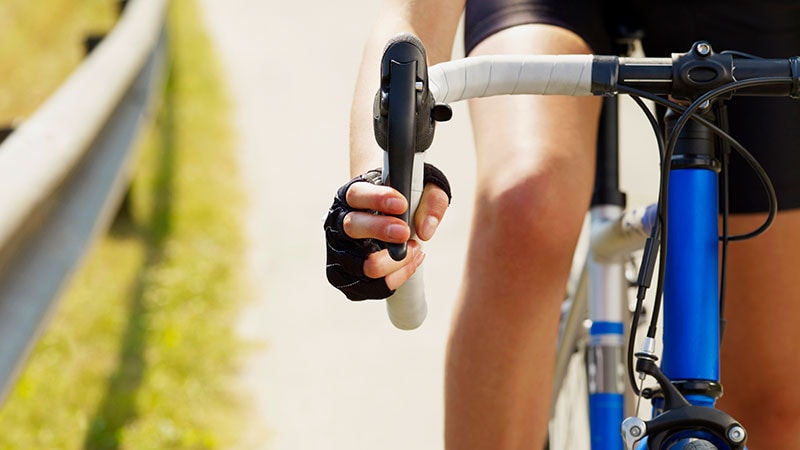As the Olympic torch heads toward Paris for the opening ceremony of the 2024 Olympics, another has left Paris en route to Milan, this one carried on the shoulders of orthopedic surgeons as they cycle through the mountain ranges of Lombardy, Italy. The torch might be slightly different in appearance and purpose, but the event itself is akin to Olympic road cycling in terms of its demands: This year’s group of riders will be clocking an average of 100 km/d over 6 days, with a total climb of 7500 meters.
The cycling event — aptly named “Cycle for Science” — is held biennially ahead of the European Society of Sports Traumatology, Knee Surgery and Arthroscopy (ESSKA) Congress, which is held this year in Milan from May 5 to 8. Participating cyclists represent 15 countries, including the UK, Norway, Germany, Ukraine, the US, and as far away as Brazil and Malaysia.
“It’s important to lead by example and show that it is important to move,” said C. Niek van Dijk, MD, PhD, who founded the ride in 2016. Van Dijk is one of the world’s leading specialists in sports traumatology and ankle surgery. He is currently head of the ankle unit at FIFA Medical Centres of Excellence in Madrid, Spain, and Porto, Portugal, and practices orthopedic surgery at Casa di Cura Privata San Rossore in Pisa, Italy. Ironically, van Dijk was not a cyclist when he conceived of the event.
“Of course, like all Dutch inhabitants, I had a bicycle, but I was not a cyclist,” he recalled. “I first bought myself a racing bicycle when I got the idea of organizing the ride and started practicing, and really loved it,” he said.
Motion Is Life
Van Dijk explained that one of the key goals of Cycle for Science is to lead by example. “Motion is life, and without motion there is no life,” he said. Moreover, staying physically active is part and parcel of being an orthopedic surgeon.
“I could not work as much as a surgeon if I didn’t exercise at the same time,” said Berte Bøe, MD, PhD, a complex knee and shoulder surgeon and head of the arthroscopy unit at Oslo University Hospital in Norway, speaking to Medscape Medical News. An avid cross-country skier and runner, as well as a first-time participant in the Cycle for Science initiative, Bøe said that staying in shape and trying to be healthy influences how she advises her patients, including recommendations to engage in strengthening exercises and resume regular physical activity postsurgery. But she also pointed to the mental benefits.
“I do something almost every day, whether it’s bicycling back and forth to my hospital or going on a small walk. If I didn’t have these mental breaks, I would not be able to do my job as well,” she said. “Of course, when you do exercise, you have more strength and can probably do more physical work and stand for long periods of time.”
“Our jobs are heavy; we do surgery standing up and the hours are long,” said van Dijk. “Exercise helps keep oneself fit. And it’s clear that you will be able to motivate your patients better when you are exercising yourself.”
With regard to cycling specifically, van Dijk noted the importance of the movement. “You can do it at an older age, and when you have arthritic joints, especially arthritic knees and hips, which can prevent you from running and long walking,” he said.
Cycle for Science 2024
In addition to emphasizing the importance of exercise, previous Cycle for Science events have raised money for the ESSKA foundation and orthopedic research through charity dinners and auctions along the route. This year’s ride will also include scientific lectures held in the afternoon after the morning rides.
six stages; it starts and ends in Milan and
passes through Varese, Bergamo, Bellagio,
Salò, and Brescia.
As a first-time rider, Bøe also sees it as an opportunity to complement her work as vice general secretary on the ESSKA Board. “I work with them to develop the organization further,” she explained, noting that the ride provides an opportunity to “cheer for each other, look after each other, and get to know one another.”
Though Van Dijk will miss this year’s ride owing to personal reasons, his enthusiasm has not waned. “As orthopedic surgeons, any type of sport that can advocate to the general public and stimulate others to start moving is important,” he said.
The torch being carried from Paris to Milan holds symbolic meaning for an organization devoted to sport and the athletes in all of us. Perhaps the Olympic motto “Citius, Altius, Fortius” (Faster, Higher, Stronger) also applies!
Cycle for Science is Supported by ESSKA. Van Dijk and Bøe report no relevant financial relationships.
Liz Scherer is a US-based independent health and medicine journalist.
>>> Read full article>>>
Copyright for syndicated content belongs to the linked Source : Medscape – https://www.medscape.com/viewarticle/orthopedic-cyclists-aim-high-ahead-biennial-congress-2024a10008m6
